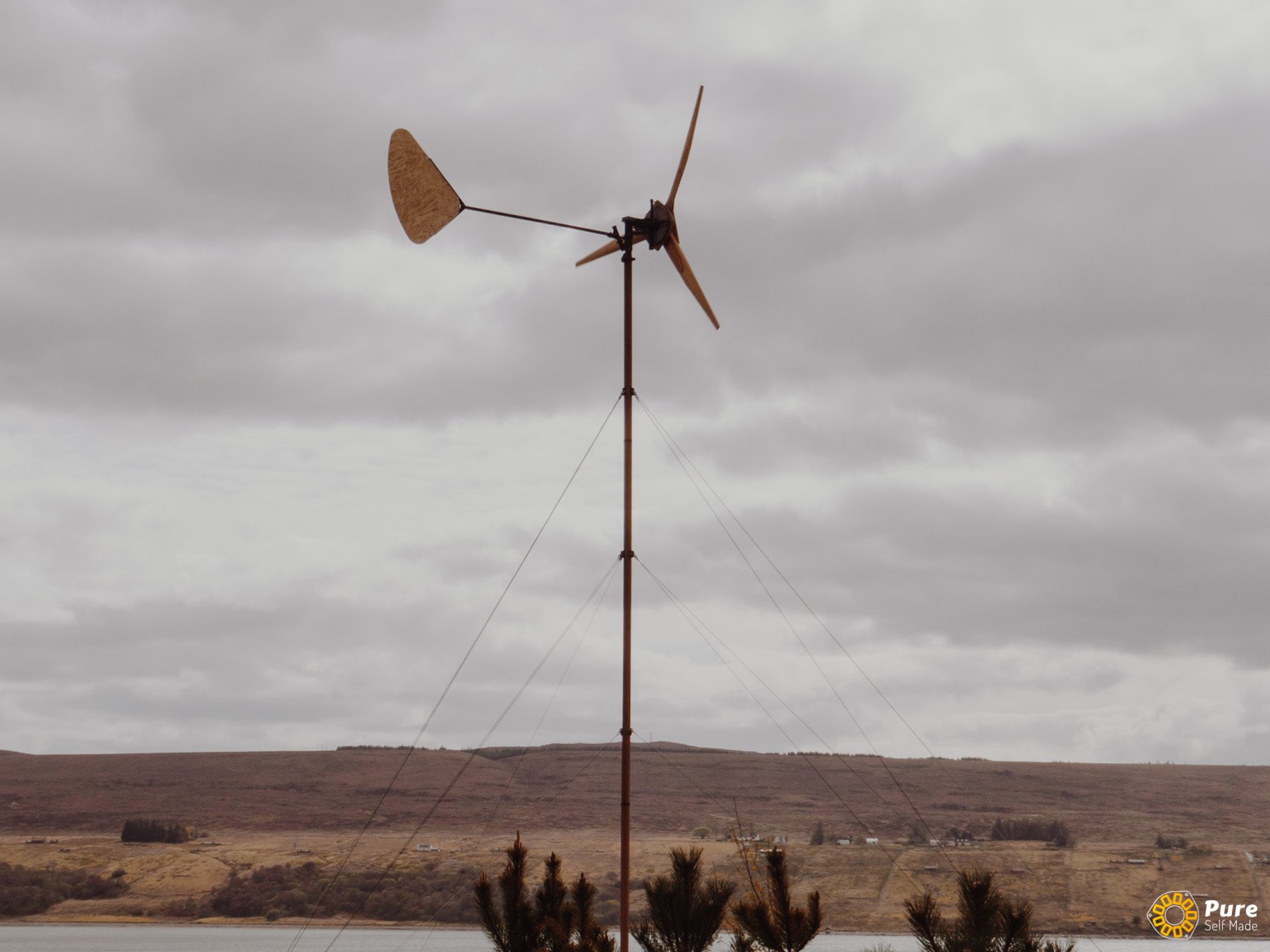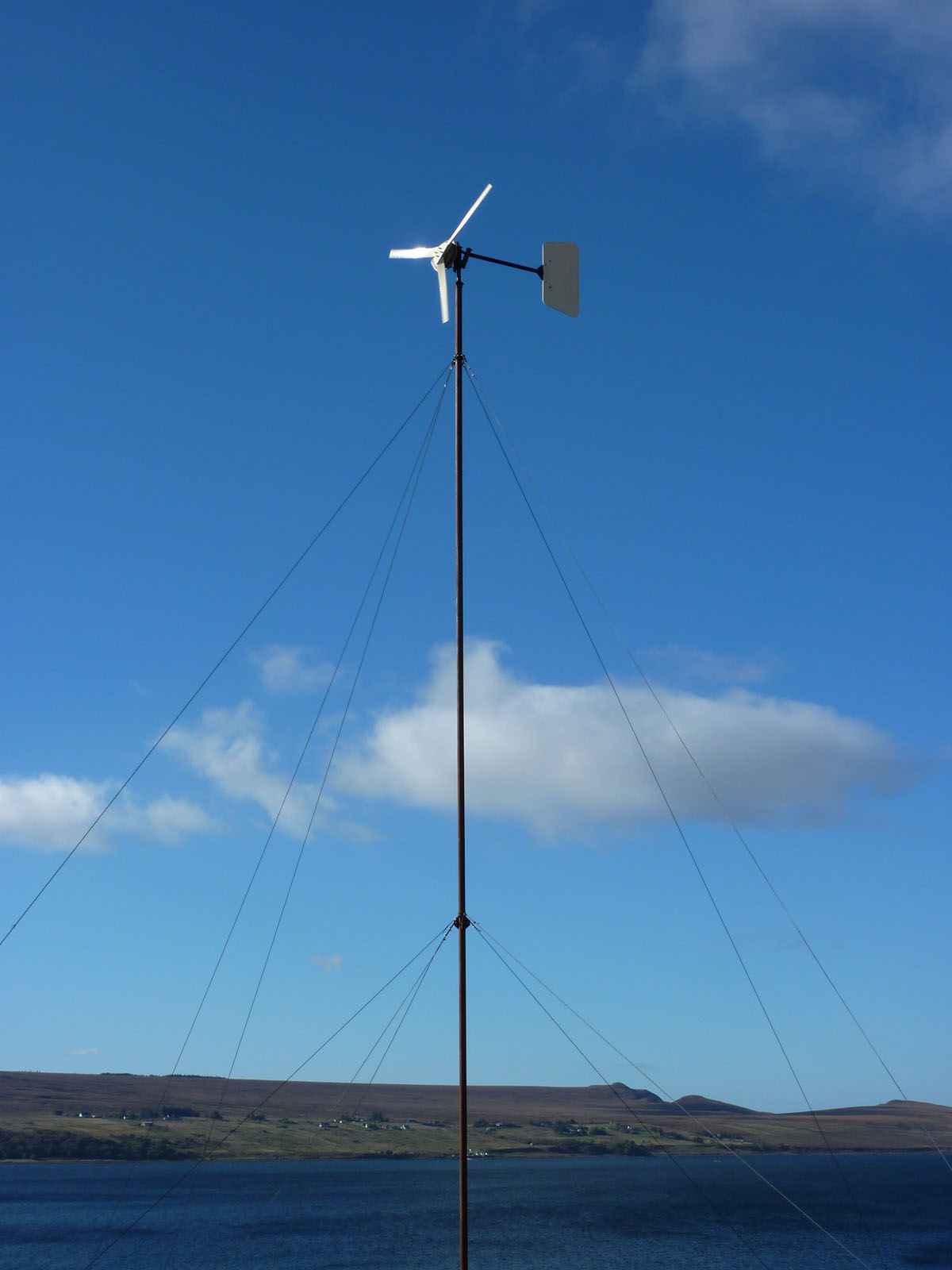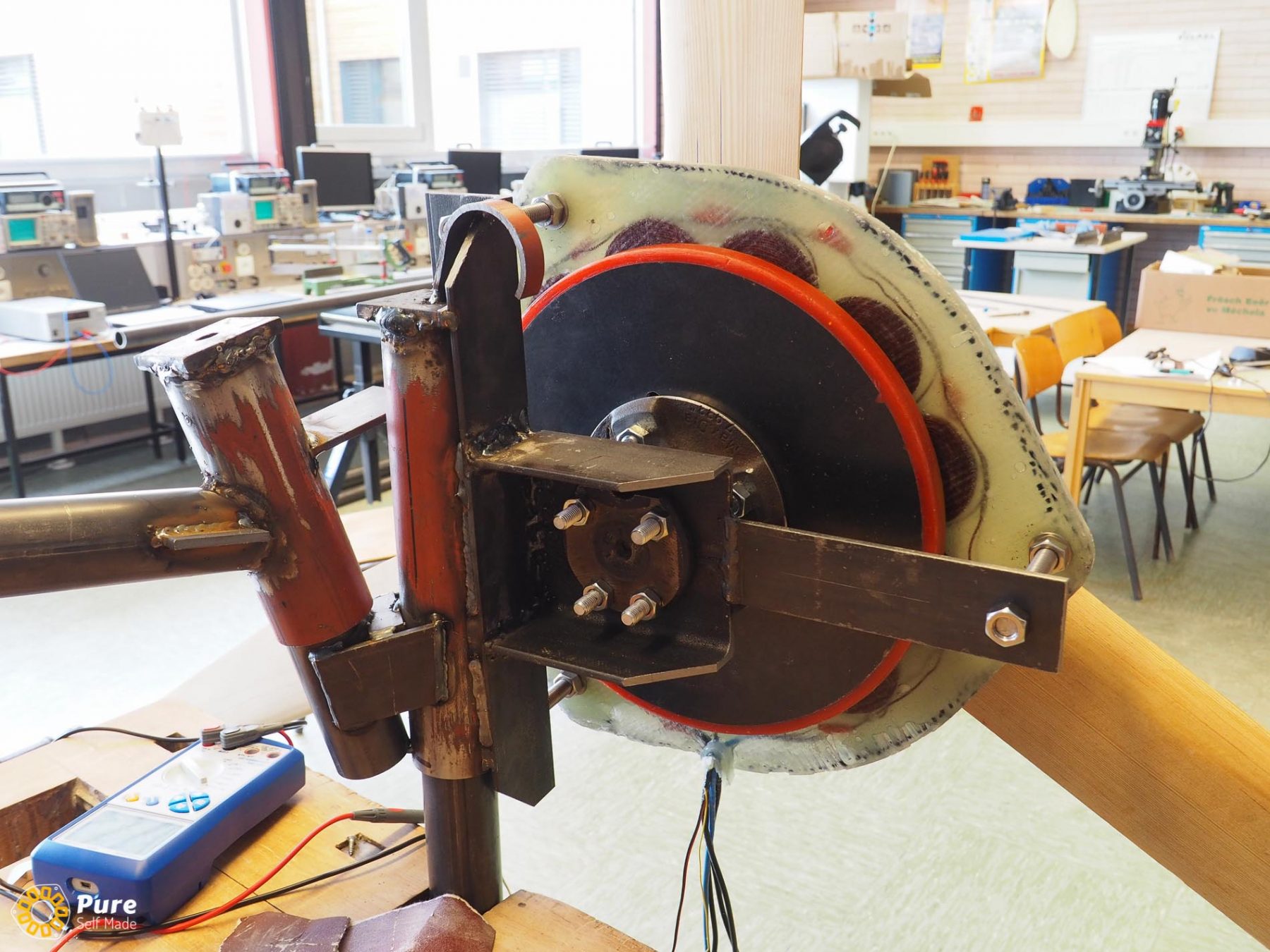The Ferrite Generator Wind Turbines used by PureSelfMade
These are the wind turbines that we build in our workshops & projects. These designs are all based on the drafts of our good friend Hugh Piggott and have been further developed in multiple ways during our Projects and in regular collaboration with Hugh Piggott.
New courses for 2023 now open for registration!
All these wind turbines can be built for off-grid or micro grid system using DC-coupling to directly charge a 12, 24 or 48 V battery. AC-coupling via a wind grid-tie inverter is also possible to feed power into a 230V/50Hz mains level system. We are basically free to choose the operating voltage range for the turbines by adapting the generator coil windings to our needs with the right calculations.

The 2.2F Piggott Turbine
The 2.2F Piggott Turbine Design
- 2.2 m rotor diameter
- 550-700W rated power output at 11 m/s wind speed, up to 1000W peaks with well-set power curve (estimated).
- Annual energy production (estimate):
~ 450 kWh / Jahr @ 4 m/s
~ 800 kWh / Jahr @ 5 m/s
~ 1300 kWh / Jahr @ 6 m/s - ~ 500€ material cost (turbine only), normally around 1500€ incl. tower and electrics.

The 3F Piggott Turbine
The 3F Piggott Turbine Design
- 3 m rotor diameter
- 1000W rated power output at 12 m/s wind speed (estimated)
- Annual energy production:
~750 kWh / year @ 4 m/s
~1400 kWh / year @ 5 m/s
~2400 kWh / year @ 6 m/s - ~ 900€ material cost (turbine only)

The 4F Turbine
The 4F Piggott Turbine Design
- 4 m rotor diameter
- 2000W rated power output at 12 m/s wind speed (estimated, can be more)
- ~1300 kWh / year @ 4 m/s
~2400 kWh / year @ 5 m/s
~3800 kWh / year @ 6 m/s - ~1200€ material cost (turbine only)
All F-Series turbine plans are included in the new wind turbine DIY Book.
Everything you need to build your own wind turbine!
The “F” machines use Ferrite permanent magnets in their generators. Why you might ask, since they are less strong than high-end rare earth neodymium magnets? While that is true, they have some great advantages too: Ferrite magnets are based on ceramic material and do not corrode. That is great to expand a turbine’s lifetime and avoid magnet disc corrosion issues which frequently occur with turbines using Neodymium magnets. Ferrite magnets are also much cheaper than neodymium magnets and less bad for the environment.
All ‘F-Series’ turbines are constructed in a similar way. They have a rotor of three wooden hand carved blades, a disc generator of two magnet rotors and one stator, a steel frame holding everything together and a tail that makes the machine face the wind. The tail also works as an overload control – when the wind speed rises too high for the turbine, it swings to the side and makes the whole turbine “furl” out of the main wind direction. This is achieved by using mechanic forces and wind pressure only, no electronics involved.
The rated power output of a wind turbine is the maximum power a wind turbine is designed to produce. This value will only be reached in high winds and is therefore not very informative. Much more important is the amount of energy produced over a certain period of time.
The kWh numbers given above are calculated using an average wind speed. In reality, the energy production will be higher, because power in the wind rises with the cube of the wind speed. Therefore, deviations above the average wind speed will have a greater impact on energy production than deviations below the average.
To get a more accurate result when trying to predict energy production, you need to have more detailed information than the average wind speed. If you calculate with the actual wind speeds over a period of time , you can calculate the deviations off the average caused by the cubic curve. The data would look like this for example:
234h – 4 m/s
375h – 5 m/s
286h – 6 m/s
478h – 7 m/s
and so on… Good data logging devices can record this kind of data.
The power a wind turbine delivers rises:
- with the rotor diameter squared
- with the wind speed cubed
That means:
- Twice the diameter gives you 4 times more power.
It also requires 4 times the strength in the construction and will cost more. - Twice the wind speed will give you 8 times the power, at the same cost.
Considering these laws of physics, it’s always better to have more wind (a higher tower or a better site) than a bigger turbine.
The environmental impact
Is it “greener” to build a DIY wind turbine at home than buying a commercial one?
This question is quite hard to answer. For a really accurate calculation of the environmental footprint, you would need to know all the energy used and all the co2 emitted while building the turbine. This also includes the manufacturing of the individual materials and their shipping. It becomes clear that it is difficult to get proper results.
A definitive advantage of the DIY turbine is, that you are more flexible. You can chose the raw materials yourself and you’re also able to recycle a lot, if you have resources of second hand stuff. It’s not very hard to find scrap metal or other useful parts for a wind turbine. Everything you recycle is something that doesn’t need to be produced newly, so that saves a lot of energy and makes your DIY turbine ‘greener’.
It’s worth considering the following: One kg of Aluminum for example takes about 50 kWh in manufacture and steel is not much different. The turbine needs to work quite a while to bring that back in. Recycling of materials makes the turbine’s footprint much smaller.
But still: Even if the machine has produced the same amount of energy that was used in the manufacturing, the fact that the production processes of many raw materials releases toxic waste into the environment remains…
The cost of self-made small wind turbines
In most cases it will be cheaper to build a wind turbine yourself than buying a commercial one. This is because building it yourself will eliminate all cost spent on marketing and labour. For example, the cost of materials for the 2F machine is 350€ – 450€. That’s for the turbine head only, any additional system components are not included.
A commercial turbine of the same size would cost you more in most cases, if you want to get a decent quality machine.
It’s also a matter of fact that the cost of DIY project always varies greatly with the source of materials you choose. If you can find second hand steel on the scrapyard or you already got suitable wood lying around, it will save you some money.
Regarding energy production the Piggott turbines can definitely compete with commercial small wind turbines of the same size. And while building it yourself you will gain a lot of experience and have fun as well – these kinds of profits can often not be measured in numbers.
So if you ask me, doing it yourself is totally worth it!
I provide the knowledge needed in my workshops. and in the new Book.
When does it make sense to install a small wind turbine?

A 2F Piggott turbine at a good site
It’s worth doing a bit of planning when it comes to small wind turbines as an energy source. I know one of the biggest reasons for making a home built wind turbine is that it’s a lot of fun to build one and to see the fruits of your labour when it’s producing a steady stream of current in a good breeze.
But when does it make sense to put up a small wind turbine if you go for serious energy production, with the hard facts in the back of your head?
The most important thing you need to run a turbine is wind of course. And that doesn’t just mean “we have a windy place here so it should be fine”. Your site should be exposed and you really should to have a constantly blowing wind stream, without serious obstacles around your turbine. If you have trees or buildings around and your turbine tower doesn’t really go way up above those objects, the air is usually turbulent. This will cause some of wear on the wind turbine and can reduce the energy production compared to a perfectly open site.
I know there are a lot of urban wind power projects, but obstacles causing turbulence are a big issue in urban areas, so I am sceptic about urban wind power, but we will see how urban wind projects will develop…
I really like wind turbines and the way they work, but they only make sense in suitable locations. These things need to be said and considered.
For findig out if your location is suitable, it makes sense to do some wind speed measurements over a longer period of time .There are also some sites where one can tell at a first look if the site is a good or a bad one (the balcony is a bad one for example).
The good news is, that Piggott wind turbines have quite a broad range of use, because they can be built in all different sizes and system voltages, so they will fit most requirements, though still not all locations.
Off-Grid system
In this case the setup will be a battery charging wind turbine configuration that either works on battery voltage and feeds straight into the battery of the system or has a controller (MPPT) to optimize performance. Typical situations are: Buildings in remote areas, installations in developing countries, remote communication systems,… Batteries are necessary to stabilize the system voltage and to provide your system with power if there is no wind.
The energy can be used straight from the batteries as low voltage DC, but normally you will have an inverter that boosts the battery’s low voltage DC up to 230V / 50Hz AC (mains level) for your loads.
The system needs to be designed to match the loads, so you first need to know what you want to power with your off grid arrangement and then you can define how big you will have to make the components. It is not only important to know the maximum power of all the loads being switched on at the same time, it’s also very important to define how long each load will be switched on in a day. You will need to know that in oder to determine the energy consumption, the suitable battery capacity, the size of the wind turbine, and so on…
Feeding into the electricity grid
That’s the way to go if you are not off-grid and want to use the turbine as a “green” energy source. In this case you will need a grid tie inverter that is connected straight to the wind turbine and feeds the energy into the grid. You normally will not need a battery in this scenario, although there are hybrid systems which have a battery as well, so you can run your system even if the grid drops out.
In a grid connected system you can easily use way more energy than your turbine can produce – it will just come out of the grid.
For this setup, the generator of the wind turbine needs to have the right output voltage for the grid tie inverter, so it is a good idea to know which inverter will be used in advance and make the generator windings in a way to fit the inverter’s needs. Also some kind of over-voltage protection circuit is needed to save the inverter from high voltages caused by the turbine in the case of failure.
In general it makes sense to combine a small wind turbine with some photovoltaic panels (PV), because sun and wind are two resources which supplement each other very well. If there is a thunderstorm, there won’t be sun, but on a calm sunny day, there might be no wind….
I will extend this article & write more about this topics soon.


